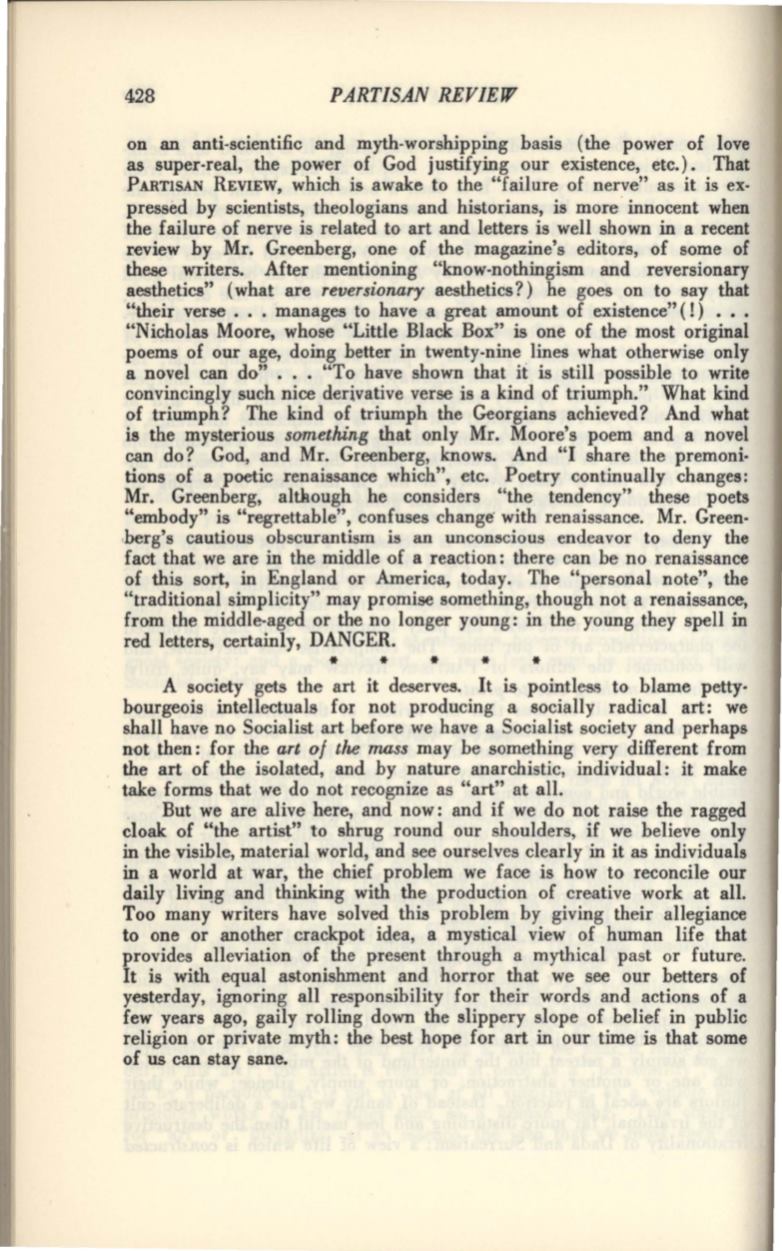
428
PARTISAN REVIEW
on an anti-scientific and myth-worshipping basis (the power of love
as super-real, the power of God justifying our existence, etc.). That
PARTISAN
REVIEW, which is awake to the "failure of nerve" as it is ex–
pressed by scientists, theologians and historians, is more · innocent when
the failure of nerve is related to art and letters is well shown in a recent
review by Mr. Greenberg, one of the magazine's editors, of some of
these writers. After mentioning "know-nothingism and reversionary
aesthetics" (what are
reversionary
aesthetics?) he goes on to say that
"their verse ... manages to have a great amount of existence"
(!) ...
"Nicholas Moore, whose "Little Black Box" is one of the most original
poems of our age, doing better in twenty-nine lines what otherwise only
a novel can do" ... "To have shown that it is still possible to write
convincingly such nice derivative verse is a kind of triumph." What kind
of triumph? The kind of triumph the Georgians achieved? And what
is the mysterious
something
that only Mr. Moore's poem and a novel
can do? God, and Mr. Greenberg, knows. And "I share the premoni–
tions of a poetic renaissance which", etc. Poetry continually changes:
Mr. Greenberg, alt:Rough he considers "the tendency" these poets
"embody" is "regrettable", confuses change with renaissance. Mr. Green–
,berg's cautious obscurantism is an unconscious endeavor to deny the
fact that we are in the middle ·of a reaction: there can be no renaissance
of this sort, in England or America, today. The "personal note", the
"traditional simplicity" may promise something, though not a renaissance,
from the middle-aged or the no longer young: in the young they spell in
red letters, certainly, DANGER.
*
*
*
*
*
A society gets the art it deserves. It
is
pointless to blame petty·
bourgeois intellectuals for not producing a socially radical art: we
shall have no Socialist art before we have a Socialist society and perhaps
not then: for the
art of
the
mass
may be something very different from
the art of the isolated, and by nature anarchistic, individual: it make
take forms that we do not recognize as "art" at all.
But we are alive here, and now: and if we do not raise the ragged
cloak of "the artist" to shrug round our shoulders, if we believe only
in the visible, material world, and see ourselves clearly in it as individuals
in a world at war, the chief problem we face is how to reconcile our
daily
liv~g
and thinking with the production of creative work at all.
Too many writers have solved this problem by giving their allegiance
to one or another crackpot idea, a mystical view of human life that
provides alleviation of the present through a mythical past or future.
It is with equal astonishment and horror that we see our betters of
yesterday, ignoring all responsibility for their words and actions of a
few years ago, gaily rolling down the slippery slope of belief in public
religion or private myth: ·the best hope for art in our time is that some
of us can stay sane.


